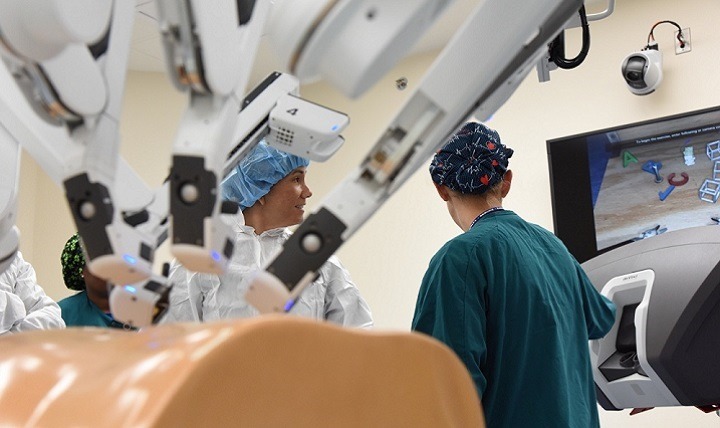As surgical robots solve the current boundaries present in minimally-invasive surgeries, the market is expanding through new machines being innovated by major manufacturers

Medical robots are designed to assist surgeons with minimally invasive techniques during surgical procedures (Credit: Air Force Medical Service)
Increased research and development from major medical technology manufacturers is helping to drive growth in the surgical robotics market, according to a new report.
The research by business analytics firm Global Data, predicts that value of the surgical robotics market will reach $7.4bn (£5.8bn) by 2028.
Medical robots are designed to assist surgeons with minimally-invasive techniques during surgical procedures to improve workflow and precisions.
Atif Nawaz, medical devices analyst at Global Data, said that while medical robot manufacturer Intuitive Surgical has remained at the forefront with its da Vinci line of minimally invasive surgical technologies, global medtech leaders like Medtronic are entering the space and will “bolster the market with portfolio proliferation”.
“The major revenue contribution comes from robotic surgical system disposables with a 70-30 split between disposables and systems,” he said.
“The installed base of the surgical systems is increasing at a compound annual growth rate (CAGR) of 9.6%.”
How Medtronic’s upcoming surgical robot will drive the market
Medtronic announced a partnership with a medical devices company Karl Storz SE & Co, after working together for almost four years.
It is the first time the collaboration has been made public in order to “enable upcoming regulatory filings”, according to Megan Rosengarten, vice president and general manager of Medtronic’s surgical robotics business.
The cooperation will see the integration of the Germany-based company’s three-dimensional vision systems and visualisation components with Medtronic’s surgical robotics system, but neither companies will unveil its new robot-assisted surgery platform until autumn.
Ms Rosengarten said: “Visualisation is critical to the successful execution of robotic assisted and minimally-invasive surgeries.
“As we developed our robotic platform, we led with surgeons’ input to design a flexible surgical system that meets their needs and the needs of patients around the globe.
“Surgeons can be confident our robotic assisted platform will provide market leading 3D visualisation technology combined with best-in-class surgical stapling and energy instruments.”

Established in 150 countries, the Dublin-based company is already active in the robot-assisted spine surgery space after launching its Mazor X Stealth robotic-assisted spinal surgical platform in the US earlier this year after being cleared by the Food and Drug Administration (FDA) – the US federal agency for health.
The technology uses a software to plan the surgical procedure and a robotic arm to guide implants and instruments through the steps of the surgery using real-time imaging feedback.
Mr Nawaz said: “With the advent of technology, each industry scales and reaps the benefits; medical devices are no different and robotic surgery has come a long way.”
According to Global Data’s report Robotic Surgery – General Surgery Market Analysis and Forecast Model, South and Central America will be one of the fastest growing regions at a CAGR of 8.1% between 2018 and 2028, with Europe following closely behind.
He added: “Robotic surgical systems are designed to solve the limitations currently present in minimally-invasive surgeries, as well as improve outcomes in open surgical procedures.
“These systems are used in a variety of surgical procedures, including cardiovascular, general surgery, orthopaedic, neurosurgery, obstetrics, gynaecology and urology.”
